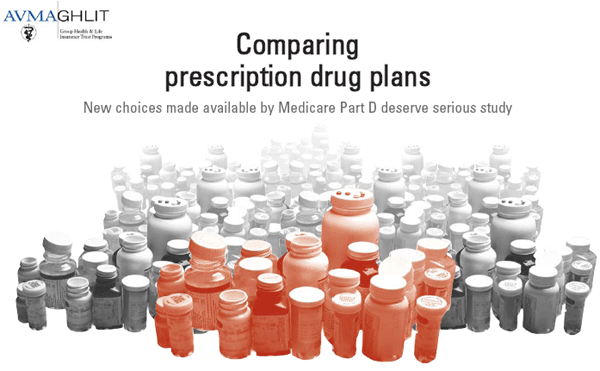Comparing prescription drug plans
|
In November, millions of Americans became eligible to enroll in the Medicare Prescription Drug Plan, also known as Medicare Part D. With the introduction of Medicare Part D, benefits and regulations governing AVMA Group Health & Life Insurance Trust medical coverage for Medicare-eligible members and their families changed (see JAVMA, Oct. 15, 2005). Individuals making plans for retirement or assisting family members with health care decisions should invest some time in understanding all the options available if they choose to enroll in Medicare Part D. The first decision—whether to enroll—can be complex. Nearly all individuals who choose to enroll will pick from dozens of Medicare prescription drug plans. One plan may require the insured to pay a flat percentage of any prescription, while another plan may require a tiered co-pay based on whether the drug is generic, a preferred brand name, or another brand name. Also, the specific drugs covered and how they are covered differ by plans. Some plans have a gap in coverage, or a "donut hole," while other plans are structured to eliminate the gap. Plans also vary by premiums and out-of-pocket costs. Some plans require the use of certain pharmacies. Some plans offer mail-order convenience while others do not. Individuals may compare plans in their area by visiting here, and then clicking on their state to view a comparative overview grid of the various plans, premiums, and benefits. It is important to prepare a list of one's current prescriptions, including dosages, to assist in comparing the overall prescription drug costs. Individuals will need to compare the formularies of available plans against their current prescriptions. Detailed information on a specific plan can be obtained directly from the insurer. Individuals planning to drop current coverage in favor of Medicare coverage have a few more issues to consider. Some plans do not allow an insured to drop prescription coverage without also dropping health coverage, and once coverage is dropped, the individual may not be eligible to re-enroll. On the other hand, some individuals may be able to enroll in Medicare Part D and retain their current coverage. For veterinarians and their spouses who are insured through GHLIT Plan E, prescription drug coverage is offered in conjunction with health coverage. If Medicare Part D is elected, then GHLIT Plan E coverage will not include prescription drugs as eligible expenses, which will reflect a lower premium of approximately 30 percent. Participants in AVMA GHLIT major-medical plans (eg, Traditional, PPO, PPO Value, and HSA-qualified plans) who became eligible for Medicare on Nov. 1, 2005, or later, will still be eligible to receive current health and prescription drug benefits if they choose to enroll in a Medicare prescription drug plan. Benefits are coordinated with Medicare and are generally paid secondarily to Medicare. Secondary benefits are an important consideration in calculating potential exposure to health care and prescription drug costs under Medicare plans. The availability of secondary benefits may help avoid the Medicare Part D "gap" in coverage. The gap refers to an uninsured area within the Medicare plan. Under "standard" Medicare Part D, the insured pays a $250 deductible and a coinsurance of 25 percent for each prescription until reaching a limit of $2,250 in total prescription costs, including deductible and coinsurance. Medicare Part D coverage then stops until total prescription costs reach $5,100. In other words, the insured pays 100 percent of the next $2,850 in prescription costs, which represents the gap in coverage. The Medicare plan then picks up about 95 percent of additional prescription costs. Medicare Part D was designed this way to be able to cover some initial prescription costs, and then offer a safety net to individuals with catastrophic claims. Potential savings with Medicare Part D will vary widely, depending upon an individual's circumstances. Individuals with a chronic illness that requires ongoing prescriptions may cross the high threshold. For individuals who only occasionally require a prescription, the decision to enroll in Medicare Part D might hinge on the peace of mind in knowing a safety net is available should a serious medical condition develop that pushes prescription drug costs to a catastrophic amount. Individuals, especially those whose prescription expenses fall within the gap, must consider total out-of-pocket expenses before choosing whether to enroll. In addition to peace of mind, there is another benefit to enrolling now in Medicare Part D. For many individuals, including those without prescription drug coverage, now is the most affordable time to enroll. Late enrollment will cost an increase in premium of approximately 1 percent per month. For example, an individual enrolling a year later could pay a premium that is 12 percent higher. Individuals who enroll later because they were participating in a qualified plan with creditable coverage may be exempt from the late fees. If a plan is deemed, on average, to be at least as good as the Medicare standard prescription drug coverage, or "creditable," the insured can keep that plan. They can also enroll in Medicare Part D at a future date without paying late fees. The enrollment must occur within 63 days of ending the other coverage. If the current coverage is deemed, on average, to not be as good as the Medicare standard prescription coverage, or noncreditable, then enrollment in Medicare Part D must occur before May 15, 2006, to avoid late fees. Once enrolled in a Medicare plan, individuals may switch plans at a future date under certain circumstances. Individuals who move or enter a nursing home, for example, can switch plans. In most cases, however, switching to a new plan is allowed only during open enrollment, which is Nov. 15-Dec. 31 of every year. Because of the importance of any decision regarding health care and prescription drug coverage, individuals should contact their current insurance plan for help in evaluating the options. AVMA GHLIT participants can get more information from the Trust office by calling (800) 621-6360. 
| ||
